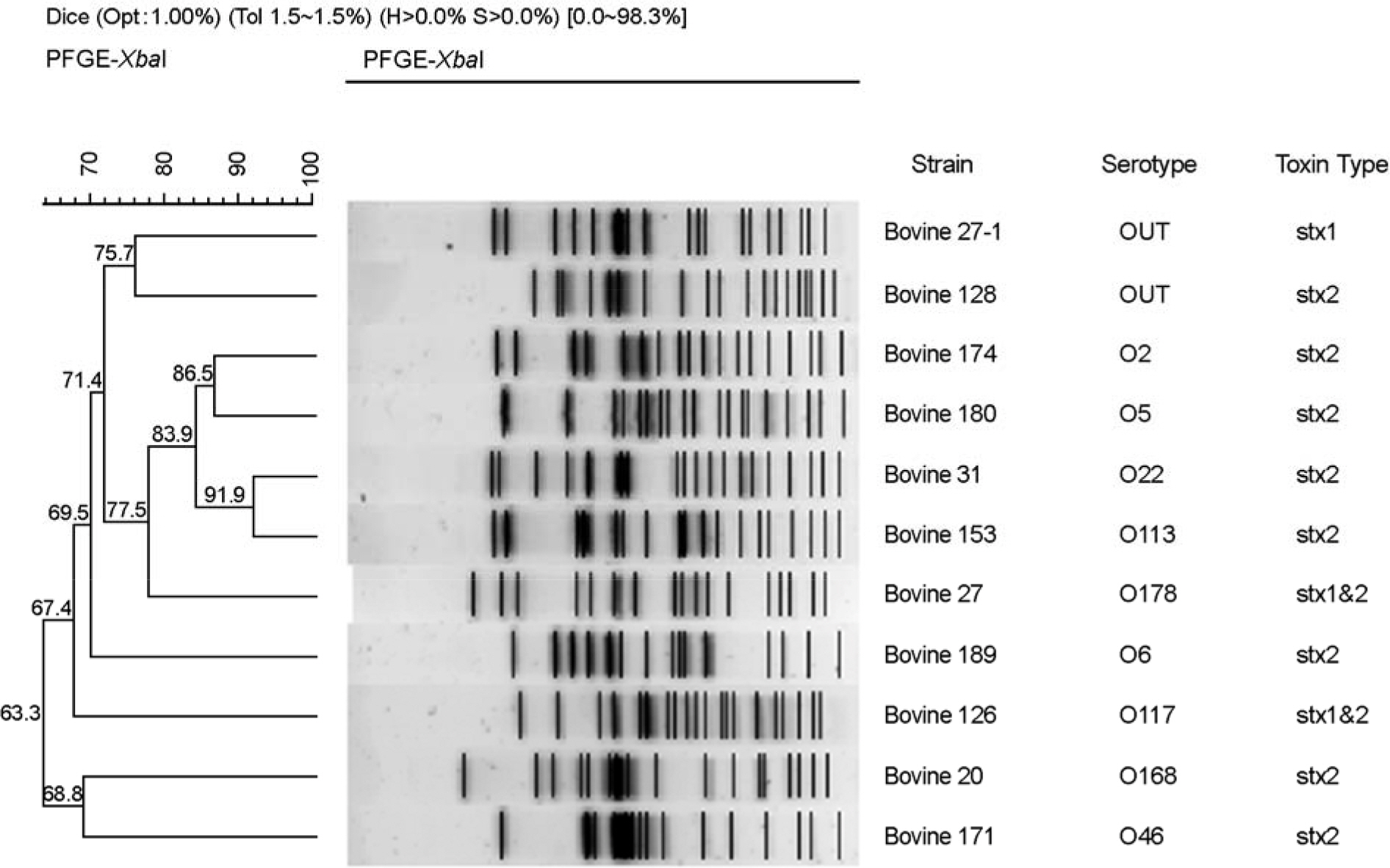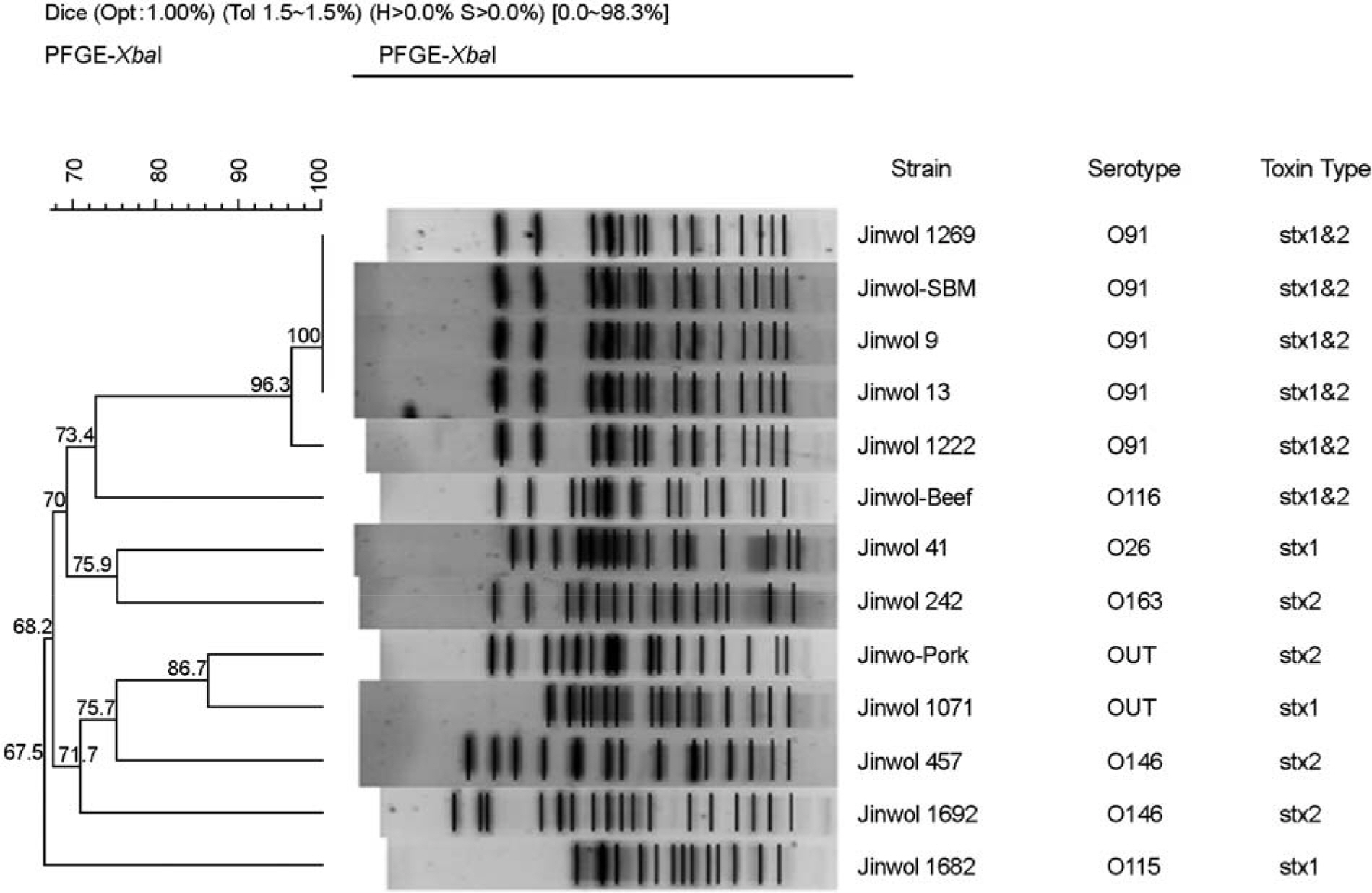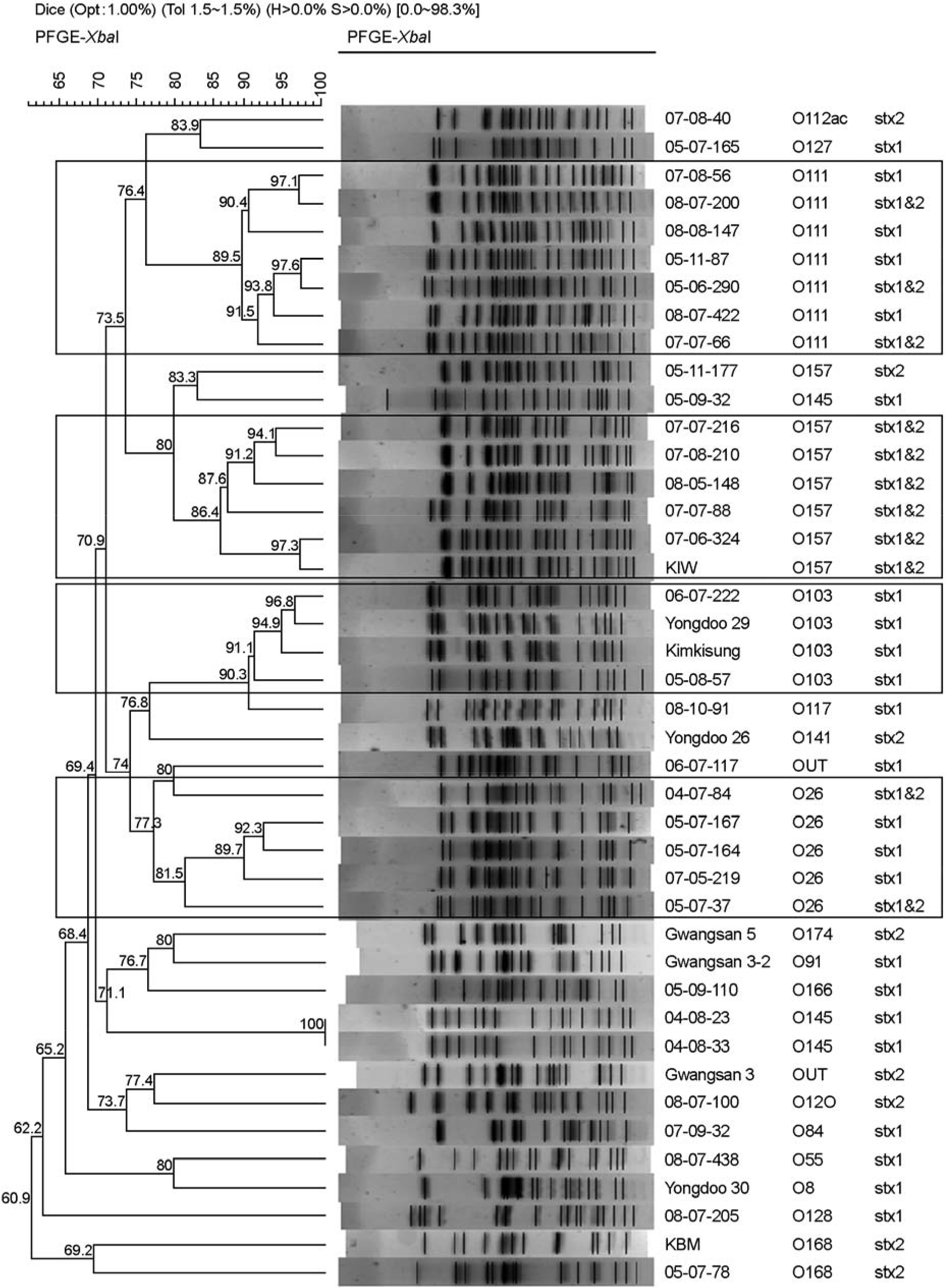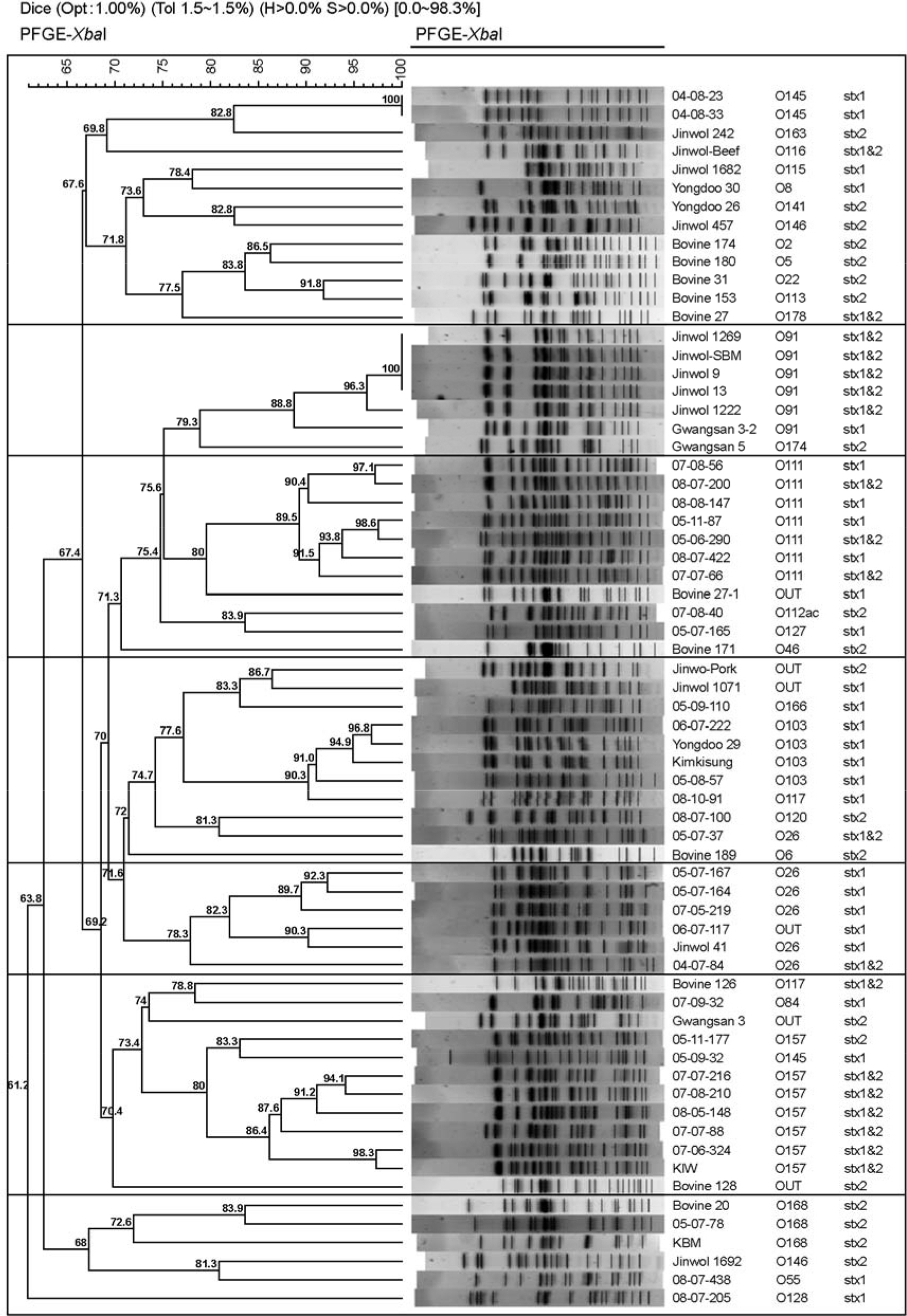J Bacteriol Virol.
2009 Sep;39(3):195-203. 10.4167/jbv.2009.39.3.195.
Epidemiological Analysis of Shiga Toxin-producing E. coli Isolated in Gwangju, Korea, by Pulse-field Gel Electrophoresis
- Affiliations
-
- 1Department of Clinical Pathology, Gwangju Health College University, Gwangju, Korea.
- 2Health & Environment Institute of Gwangju, Gwangju, Korea. vetmj@korea.kr
- KMID: 1474162
- DOI: http://doi.org/10.4167/jbv.2009.39.3.195
Abstract
- In Gwangju, Korea, over the last 4 years, human gastrointestinal infection caused by shiga toxin-producing E. coli (STEC) increased. The aim of this study was to ascertain the genetic relatedness of STEC strains by pulsed-field gel electrophoresis (PFGE), as no data on the molecular epidemiology of STEC in Gwangju has yet been published. The PFGE banding patterns were defined for 62 of the 67 STEC strains isolated from cattle and human. There were 11 clonal types in the 11 STEC strains of cattle origin. Among the 11 STEC strains from asymptomatic person, four O91 strains were 100% similarity in band profiles. In the STEC strains isolated from diarrhea patients, same serogroups were grouped to the same cluster; O111 stains were 89.5% similarity, O157 strains 80%, O26 strains 81.5%, and O103 strains 91% similarity, respectively. In conclusion, this is the first report that a large collection of STEC strains from Korea has been analyzed, and a high degree of diversity was observed among the strains analyzed by this technique. PFGE analysis revealed that the strains isolated from human and cattle were closely related within serotypes, and it was useful for epidemiological analysis of STEC. The importance and usefulness of active laboratory surveillance of STEC such as PFGE should be recommended.
MeSH Terms
Figure
Cited by 1 articles
-
Pathogenic and phylogenetic characteristics of non-O157 Shiga toxin-producing Escherichia coli isolates from retail meats in South Korea
June Bong Lee, Dalmuri Han, Hyung Tae Lee, Seon Mi Wi, Jeong Hoon Park, Jung-woo Jo, Young-Jae Cho, Tae-Wook Hahn, Sunjin Lee, Byunghak Kang, Hyo Sun Kwak, Jonghyun Kim, Jang Won Yoon
J Vet Sci. 2018;19(2):251-259. doi: 10.4142/jvs.2018.19.2.251.
Reference
-
1). Beutin L., Geier D., Steinruck H., Zimmermann S., Scheutz F. Prevalence and some properties of verotoxin (shiga-like toxin)-producing Escherichia coli in seven different species of healthy domestic animals. J Clin Microbiol. 1993. 31:2483–8.2). Meyer-Broseta S., Bastian SN., Arne PD., Cerf O., Sanaa M. Review of epidemiological surveys on the prevalence of contamination of healthy cattle with Escherichia coli serogroup O157:H7. Int J Hyg Environ Health. 2001. 203:347–61.3). Faith NG., Shere JA., Brosch R., Arnold KW., Ansay SE., Lee MS., Luchansky JB., Kaspar CW. Prevalence and clonal nature of Escherichia coli O157:H7 on dairy farms in Wisconsin. Appl Environ Microbiol. 1996. 62:1519–25.4). Mundy R., Petrovska L., Smollett K., Simpson N., Wilson RK., Yu J., Tu X., Rosenshine I., Clare S., Dougan G., Frankel G. Identification of a novel Citrobacter rodentium type III secreted protein, EspI, and roles of this and other secreted proteins in infection. Infect Immun. 2004. 72:2288–302.5). Hancock DD., Besser TE., Rice DH., Ebel ED., Herriot DE., Carpenter LV. Multiple sources of Escherichia coli O157 in feedlots and dairy farms in the northwestern USA. Prev Vet Med. 1998. 35:11–9.6). Gyles CL. Shiga toxin-producing Escherichia coli: An overview. J Anim Sci. 2007. 85:E45–E62.7). Heuvelink AE., Van den Biggelaar FL., De Boer E., Herbes RG., Melchers WJ., Huis in't Veld JH., Monnens LA. Isolation and characterization of verocytotoxin-producing Escherichia coli O157 strains from Dutch cattle and sheep. J Clin Microbiol. 1998. 36:878–82.8). Conedera G., Dalvit P., Martini M., Galiero G., Gramaglia M., Goffredo E., Loffredo G., Morabito S., Ottaviani D., Paterlini F., Pezzotti G., Pisanu M., Semprini P., Caprioli A. Verocytotoxin-producing Escherichia coli O157 in minced beef and dairy products in Italy. Int J Food Microbiol. 2004. 96:67–73.9). Renter DG., Sargeant JM., Hygnstorm SE., Hoffman JD., Gillespie JR. Escherichia coli O157:H7 in free-ranging deer in Nebraska. J Wildl Dis. 2001. 37:755–60.10). Chalmers RM., Salmon RL., Willshaw GA., Cheasty T., Looker N., Davies I., Wray C. Vero-cytotoxin-producing Escherichia coli O157 in a farmer handling horses. Lancet. 1997. 349:1816.11). Trevena WB., Hooper RS., Wray C., Willshaw GA., Cheasty T., Domingue G. Vero cytotoxin-producing Escherichia coli O157 associated with companion animals. Vet Rec. 1996. 138:400.12). Garcia A., Fox JG. The rabbit as a new reservoir host of enterohemorrhagic Escherichia coli. Emerg Infect Dis. 2003. 9:1592–7.13). Wallace JS., Cheasty T., Jones K. Isolation of Vero cytotoxin-producing Escherichia coli O157 from wild birds. J App Microbiol. 1997. 82:399–404.14). Makino S., Kobori H., Asakura H., Watarai M., Shirahata T., Ikeda T., Takeshi K., Tsukamoto T. Detection and characterization of Shiga toxin-production Escherichia coli from seagulls. Epidemiol Infect. 2000. 125:55–61.15). Griffin PM., Tauxe RV. The epidemiology of infections caused by Escherichia coli O157:H7, other enterohemorrhagic E. coli, and the associated hemolytic uremic syndrome. Epidemiol Rev. 1991. 13:60–98.16). Meng J., Doyle MP. Microbiology of shiga-toxin-producing Escherichia coli in foods. In:. Kaper JB, O'Brien AD, editors. (Eds.),. Escherichia coli O157:H7 and other Shiga-toxin-producing E. coli. American Society for Microbiology;Washington, DC: 1998. p. 92–108.17). McDowell DA., Sheridan JJ. Survival and growth of Vero cytotoxin-producing E. coli in the environment. in:. Duffy G, Garvey P, McDowell D, editors. (Eds.),. Verocytotoxigenic Escherichia coli. Food & Nutrition Press Inc.;Trumbull: 2001. p. 279–304.18). Rangel JM., Sparling PH., Crowe C., Griffin PM., Swerdlow DL. Epidemiology of Escherichia coli O157:H7 outbreaks, United States, 1982-2002. Emerg Infect Dis. 2005. 11:603–9.19). Tenover FC., Arbeit RD., Goering RV., Mickelsen PA., Murray BE., Persing DH., Swaminathan B. Interpreting chromosomal DNA restriction patterns produced by pulsed-field gel electrophoresis: criteria for bacterial strain typing. J Clin Microbiol. 1995. 33:2233–9.
Article20). Maiden MC., Bygraves JA., Feil E., Morelli G., Russell JE., Urwin R., Zhang Q., Zhou J., Zurth K., Caugant DA., Feavers IM., Achtman M., Spratt BG. Multilocus sequence typing: a portable approach to the identification of clones within populations of pathogenic microorganisms. Proc Natl Acad Sci USA. 1998. 95:3140–5.
Article21). Caugant DA., B⊘vre K., Gaustad P., Bryn K., Holten E., H⊘iby EA., Fr⊘holm LO. Multilocus genotypes determined by enzyme electrophoresis of Neisseria meningitidis isolated from patients with systemic disease and from healthy carriers. J Gen Microbiol. 1986. 132:641–52.22). Achtman M., van der Ende A., Zhu P., Koroleva IS., Kusecek B., Morelli G., Schuurman IG., Brieske N., Zurth K., Kostyukova NN., Platonov AE. Molecular epidemiology of serogroup a meningitis in Moscow, 1969 to 1997. Emerg Infect Dis. 2001. 7:420–7.
Article23). Keskimaki M., Saari M., Heiskanen T., Siitonen A. Shiga toxin-producing Escherichia coli in Finland from 1990 through 1997: prevalence and characteristics of isolates. J Clin Microbiol. 1998. 36:3641–6.24). Majalija S., Segal H., Ejobi F., Elisha BG. Shiga toxin gene-containing Escherichia coli from cattle and diarrheic children in the pastoral systems of southwestern Uganda. J Clin Microbiol. 2008. 46:352–354.25). Beutin L., Krause G., Zimmermann S., Kaulfuss S., Gleier K. Characterization of shiga toxin-producing Escherichia coli strains isolated from human patients in Germany over a 3-year period. J Clin Microbiol. 2004. 42:1099–108.26). Bender JB., Hedberg CW., Besser JM., Boxrud DJ., MacDonald KL., Osterholm MT. Surveillance by molecular subtype for Escherichia coli O157:H7 infections in Minnesota by molecular subtyping. N Engl J Med. 1997. 337:388–94.27). Izumiya H., Terajima J., Wada A., Inagaki Y., Itoh KI., Tamura K., Watanabe H. Molecular typing of enterohemorrhagic Escherichia coli O157:H7 isolates in Japan by using pulsed-field gel electrophoresis. J Clin Microbiol. 1997. 35:1675–80.28). Nataro JP., Kaper JB. Diarrheagenic Escherichia coli. Clin Microbiol Rev. 1998. 11:142–201.
- Full Text Links
- Actions
-
Cited
- CITED
-
- Close
- Share
- Similar articles
-
- Molecular epidemiology of sequence type 33 of Shiga toxin-producing Escherichia coli O91:H14 isolates from human patients and retail meats in Korea
- Prevalence and characteristics of Shiga toxin-producing Escherichia coli (STEC) from cattle in Korea between 2010 and 2011
- Shiga Toxin: Emerging Producer Strains, Prophylactic Approaches, and Application in Cancer Therapy
- Identification of Enterohemorrhagic Escherichia coli by Colony Hybridization with stx-specific Oligonucleotide
- Molecular Genetic Characterization of Shiga Toxin-producing E. coli Isolated from Diarrhea Patients and Cattle in Gwangju Area, Korea





